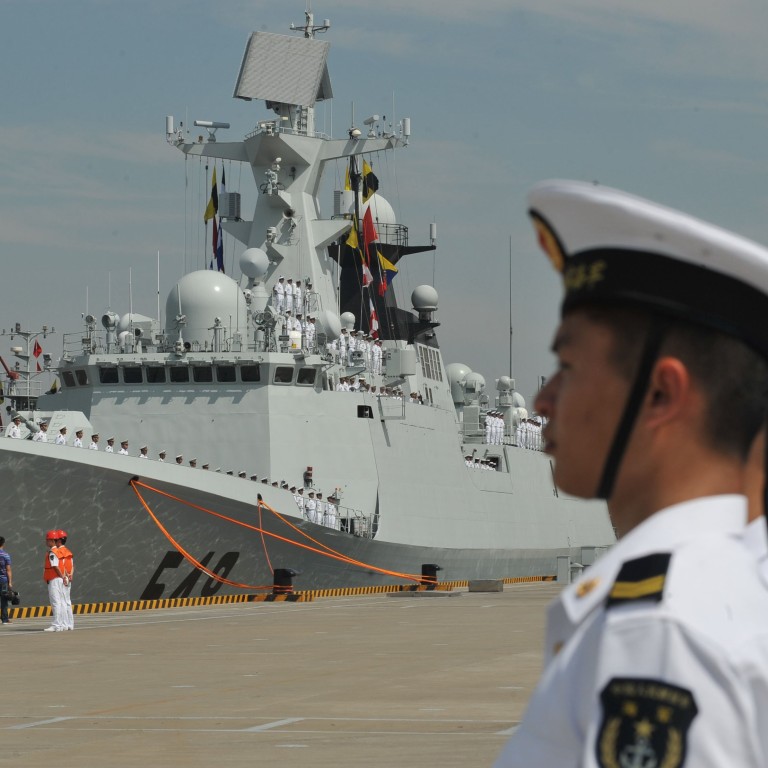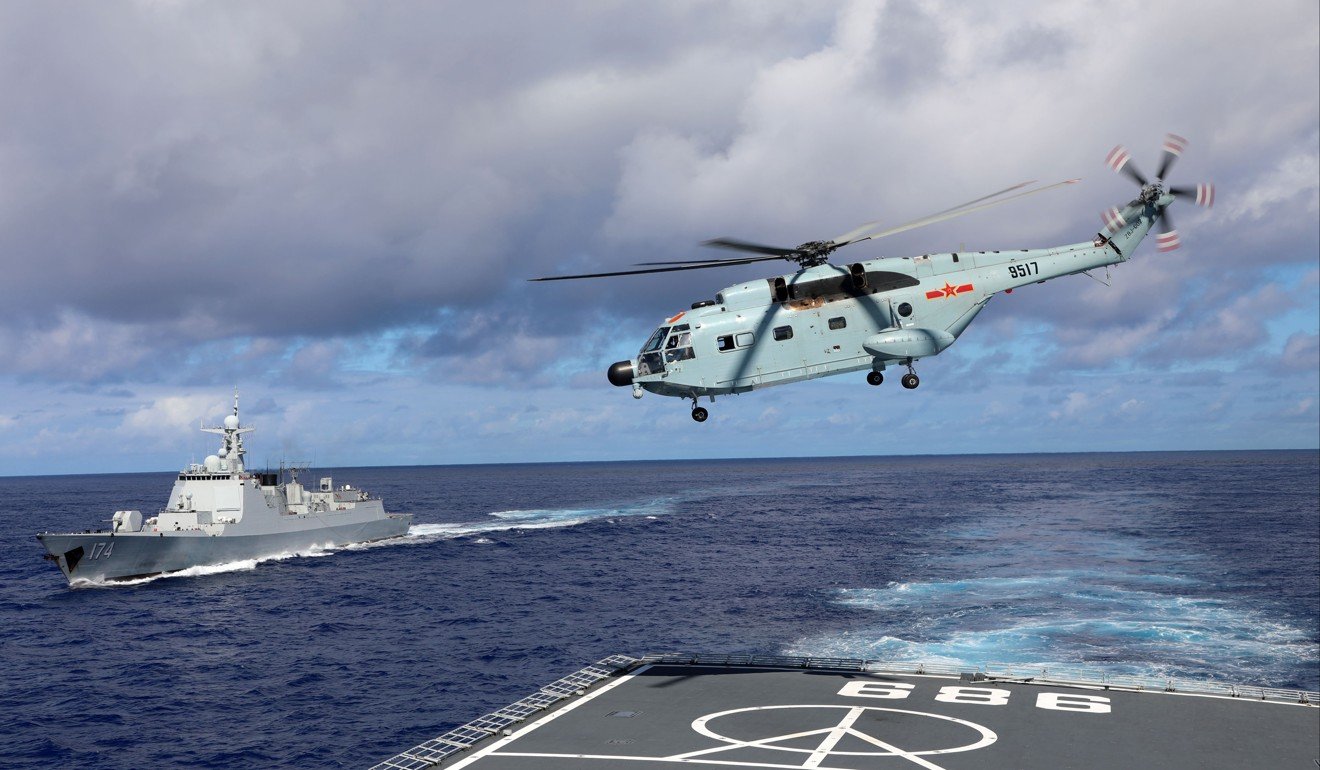
How China’s growing PLA Navy could close a perception gap in the South China Sea
- Collin Koh writes that a political solution is the way to win trust in the disputed maritime region as China’s naval force grows more powerful and modern.
As the PLA Navy stands poised to celebrate its 70th anniversary, there is much to be happy about, especially where capability modernisation is concerned.
The navy by 2000 had mustered a total of 57 submarines, only six of which were built in the 1990s and could have been considered modern and up-to-date. The same applied to only four of the total of 20 destroyers and frigates in the navy’s fleet at the time.
Fast forward to today’s PLA Navy. According to the International Institute of Strategic Studies’ 2019 assessment of global military capabilities and defence economics, 51 of China’s 59 submarines are viewed as modern and up-to-date. Meanwhile, 67 of its 86 destroyers and frigates – mostly commissioned in recent years – are top-of-the-line.
There is also a functional aircraft carrier, the Liaoning, which has served mainly as a training and test-bed carrier since 2012.
More of these powerful major surface combat ships are coming on line – supported by an equally impressive, if not always well-publicised, growing logistics support force. The increase in fleet replenishment ships to 11 from just three back in 2000 clearly signals an expanding blue-water capability.
The “mosquito fleet” of torpedo and missile fast attack craft – once the navy’s backbone, focused primarily on coastal defence and support for ground forces – has shrunk significantly over almost two decades.
A motley fleet once comprised of multiple ship classes has been replaced by a leaner, meaner force that includes, most significantly, 41 missile corvettes optimised for littoral combat duties – meaning near a shore or just off a coast – which would come in handy around regional flashpoints such as the South China Sea.
It is noteworthy that this is also an increasingly extroverted navy, especially since its debut counter-piracy mission in the Gulf of Aden in December 2008. Barely a decade since then, the navy now boasts its first operational overseas base in the eastern African country of Djibouti. Beijing has been silent about the prospect of establishing more such bases abroad.
The phenomenal build-up of the PLA Navy over these decades is nothing short of impressive, going by mere numbers and the relative modernity of the service. It has become a more balanced fleet, capable of undertaking operations within the immediate near-seas and in distant waters such as the Indian Ocean and the Western Pacific open waters.

Foreign governments and observers could marvel at this rapid growth, some with a tinge of envy.
Certainly, the PLA Navy is building more and increasingly sophisticated ships, along with aircraft for its fleet aviation – possibly more than it can staff and maintain, even with the recruiting and training of personnel.
The shiny new “toys” are, after all, delicate machines that require painstaking care and consistent resourcing to be kept fit and in service – not just for fleet reviews but a spectrum of peace- and wartime missions, as defined by the country’s national interests. As international relations theorist Ken Booth once observed, warships are inherently multi-purpose instruments of foreign policy.
But warships alone do not constitute naval capability, nor do they solely provide the capacity to cope with a range of missions.
Personnel, fleet readiness and operational availability are all factors behind an effective navy. For now, with its primary focus on the immediate near seas and secondary focus on the far seas, the PLA Navy is likely to keep up its current operational tempo.
However, long-term economic challenges could throw a spanner in the works of naval capacity-building.
Amid sluggish economic growth, China has projected a smaller spike in its defence spending. The navy plausibly is still going to grab a huge chunk of funding, but the honeymoon period of an assured influx of modernisation funds appears close to being over.

As Beijing shifts back to its traditional focus on socioeconomic development – the bedrock of the Communist Party’s political legitimacy, especially amid the loud clarion call for enhancing poverty alleviation programmes – a gradual plateauing of the shipbuilding rate could be in the future.
The objective would become to sustain a long-term fleet build-up in tandem with slower and more manageable economic growth.
Given the PLA Navy is unlikely to roll back its increasingly entrenched overseas presence, especially in the Indian Ocean, managing external perceptions is likely to remain challenging.
Over the recent decade, the navy has also become a tool of Beijing’s attempt to project “soft power” – for example, taking part in the evacuation of civilian expatriates from strife-torn Yemen in 2015 and conducting regular “Harmonious Missions” with its largest hospital ship, Peace Ark, to disburse free medical care to locals in foreign ports.
This persistent challenge of perceptions is something the 70th anniversary gala of the PLA Navy is unlikely to overcome.
While the PLA Navy maintains a generally positive image in those distant regions where Beijing has growing strategic economic interests but no outstanding geopolitical disputes, it has a mixed image in the surrounding Asia-Pacific region where territorial and sovereignty disputes persist.
The struggle for perceptions begins in these immediate waters close to China’s home shores.
The South China Sea in particular is where improved perceptions can be gained. There is probably less concern over the PLA Navy’s build-up per se, than over what Beijing is actually doing in those contentious waters – notably, its extensive militarisation efforts.
The proposed code of conduct being negotiated between China and the Association of Southeast Asian Nations (Asean) is far from certain to help alleviate those concerns. And the inaugural Asean-China Maritime Exercise held in August last year was largely symbolic.
The solution is not to slow down on the navy’s modernisation – there is little incentive to do so, given the fleet’s flexibility as a foreign policy tool.
The long-term solution, rather, will have to be political in nature. This persistent challenge of perceptions is something the 70th anniversary gala of the PLA Navy is unlikely to overcome.
In fact, it could instead pique a greater sense of regional wariness.
Collin Koh is research fellow with the Maritime Security Programme at the S. Rajaratnam School of International Studies, Nanyang Technological University, Singapore.

